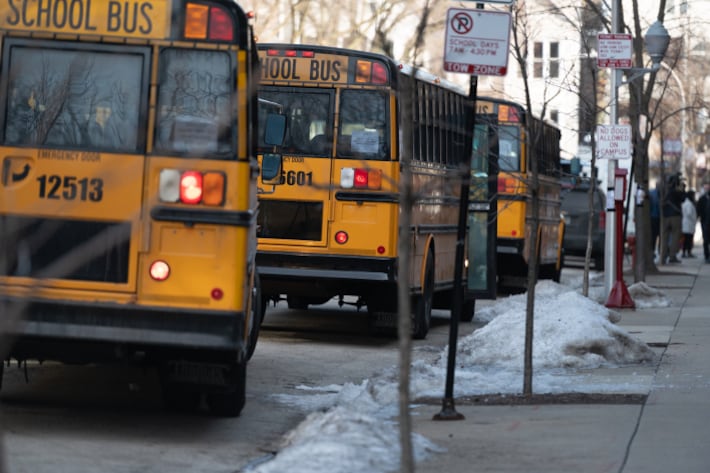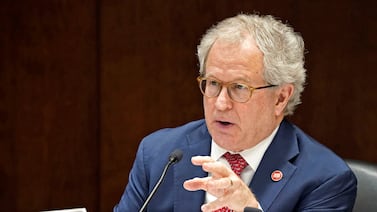Updated at 3:16 p.m.: This story was updated to reflect Chicago Public Schools’ own estimate for how much it will receive from the third stimulus effort.
Illinois is expected to receive $5.2 billion for schools in the third round of emergency federal funding, bringing its total haul of COVID-19 stimulus funding to more than $8 billion since last spring.
That amount of new funding would be welcome news for Illinois schools, which are trying to reopen and recover from a year of disruption but saw their budgets kept flat by the state this year.
Congress approved a $1.9 trillion stimulus package Wednesday that will provide $128.6 billion in funding to K-12 education. President Biden, who proposed and championed the legislation, has promised to quickly sign it into law.
The package is likely the biggest single federal outlay on K-12 education in U.S. history.
Nearly all of the funds for schools have to be distributed through the Title I formula, which means local school districts that serve lots of students from low-income families will get the biggest share. In Illinois, that means about $4.7 billion of the latest round of funding will flow directly to districts.
Chicago Public Schools, the state’s largest school district, said Wednesday afternoon that it expects to receive nearly $1.8 billion from the package. That would amount to about $5,200 additional per student, according to preliminary estimates, and bring Chicago’s total from a combined three stimulus packages to roughly $3 billion across the past year of the pandemic.
Chicago officials said that they planned to use additional money to address “unfinished learning” — the district’s No. 2, LaTanya McDade told Chalkbeat last week that a plan by that name will be made public soon — and to address the social-emotional impact and lingering trauma on students from the pandemic. The district also will use the money toward the mounting costs of reopening schools, such as student and staff testing and cleaning expenses.
“It’s never been more essential to ensure public schools — particularly those that serve high numbers of Black and Latinx students from low-income households — are equitably funded and have the resources necessary to address the unprecedented needs brought on by the pandemic,” said schools chief Janice Jackson. “These funds will ensure we can make the investments needed to address unfinished learning and mounting social and emotional needs.”
The statewide outlook
This third round of federal funding is significantly larger than the previous rounds of emergency funding that the state received — more than $569 million in the spring and almost $2.3 billion in December.
The news comes as the state education department has been lobbying legislators to put more than $350 million more into a spending formula that determines how much school districts receive each year, with another $50 million requested for early childhood education. Gov. J.B. Pritzker kept state education spending flat for a second year straight, saying he anticipated federal funding would be enough to keep districts afloat and that the state’s budget gap has forced hard choices.
Education advocates and superintendents have worried that, even with a windfall of federal emergency funding, not meeting recommended minimums in state education spending will create longer-term budget crunches for districts.
Earlier this week, state education officials testified in front of a House legislative committee that 168 school districts in Illinois are still below 60% adequate funding — and that the state would need to commit closer to $800 million additional dollars per year to meet a bipartisan goal of adequately funding every district in the state by 2027.
State Superintendent of Education Carmen Ayala said that school districts will have to use at least 20% of the latest federal emergency funds on addressing learning loss. Besides that, schools have the ability to use the money for anything from buying personal protective equipment to setting up after-school programs and tutoring interventions.
As for the share of money that the state will receive for broad spending, technology is still a priority, she said.
“There are no requirements to set aside funds for technology; however, there remains a lot of flexibility and we are really trying to close technology gaps across the state,” she said.
Illinois also plans to petition the federal government to use some of its share of its federal stimulus dollars to help fund a new statewide “Student Care” department tasked with discipline reduction, bullying prevention, and expanding trauma-informed training for educators, and it hopes to invest in teacher mentoring programs aimed at keeping more recruits in classrooms.
More money, more open classrooms?
During her testimony in front of a House committee, Ayala was asked if she would consider using some of the state’s portion of the stimulus money to incentivize more Illinois school districts to reopen classrooms and offer families full-time options for in-person schooling. Currently, more than 1.7 million students, or 89%, attend school in a district where they have the option of some in-person learning, but the state COVID-19 dashboard does not track how many students have a full-time option or have taken it.
“Are you open to tying some level of funding to requiring some … full-time education given that it is safe and in students’ best interest?” asked Rep. Blaine Wilhour, a Republican from Southern Illinois.
Ayala’s response suggested the state will leave such decisions up to superintendents: “We have really worked at encouraging in-person (learning) as much as possible, but we need to recognize that every community has their uniqueness.”
In Washington, D.C., Congressional Republicans voted against the deal en masse and criticized it for funneling money to schools that haven’t offered in-person instruction despite earlier rounds of pandemic relief.
Nationally, the stimulus package, in addition to the relief efforts passed last year, staves off concern that schools would face imminent budget cuts, which were a distinct possibility when the pandemic hit and the economy cratered. The package sets aside another $800 million to be used by the U.S. Department of Education to identify and support students who are homeless. Separately, nearly $3 billion is earmarked to support students with disabilities.
Another $2.75 billion will go to governors to distribute to private schools that serve a “significant” share of low-income students.
Another provision will temporarily expand the child tax credit, which will provide at least $3,000 per child to low- and middle-income families. Overall, the package is projected to reduce the country’s child poverty rate from 13.7% to 6.5%, with particularly large declines for Black and Latino children.





